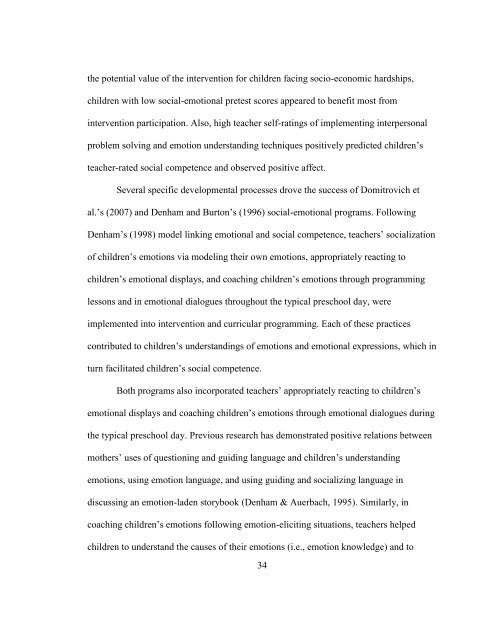Sample A: Cover Page of Thesis, Project, or Dissertation Proposal
Sample A: Cover Page of Thesis, Project, or Dissertation Proposal
Sample A: Cover Page of Thesis, Project, or Dissertation Proposal
Create successful ePaper yourself
Turn your PDF publications into a flip-book with our unique Google optimized e-Paper software.
the potential value <strong>of</strong> the intervention f<strong>or</strong> children facing socio-economic hardships,<br />
children with low social-emotional pretest sc<strong>or</strong>es appeared to benefit most from<br />
intervention participation. Also, high teacher self-ratings <strong>of</strong> implementing interpersonal<br />
problem solving and emotion understanding techniques positively predicted children‘s<br />
teacher-rated social competence and observed positive affect.<br />
Several specific developmental processes drove the success <strong>of</strong> Domitrovich et<br />
al.‘s (2007) and Denham and Burton‘s (1996) social-emotional programs. Following<br />
Denham‘s (1998) model linking emotional and social competence, teachers‘ socialization<br />
<strong>of</strong> children‘s emotions via modeling their own emotions, appropriately reacting to<br />
children‘s emotional displays, and coaching children‘s emotions through programming<br />
lessons and in emotional dialogues throughout the typical preschool day, were<br />
implemented into intervention and curricular programming. Each <strong>of</strong> these practices<br />
contributed to children‘s understandings <strong>of</strong> emotions and emotional expressions, which in<br />
turn facilitated children‘s social competence.<br />
Both programs also inc<strong>or</strong>p<strong>or</strong>ated teachers‘ appropriately reacting to children‘s<br />
emotional displays and coaching children‘s emotions through emotional dialogues during<br />
the typical preschool day. Previous research has demonstrated positive relations between<br />
mothers‘ uses <strong>of</strong> questioning and guiding language and children‘s understanding<br />
emotions, using emotion language, and using guiding and socializing language in<br />
discussing an emotion-laden st<strong>or</strong>ybook (Denham & Auerbach, 1995). Similarly, in<br />
coaching children‘s emotions following emotion-eliciting situations, teachers helped<br />
children to understand the causes <strong>of</strong> their emotions (i.e., emotion knowledge) and to<br />
34




![[Sample B: Approval/Signature Sheet] - George Mason University](https://img.yumpu.com/21978828/1/190x245/sample-b-approval-signature-sheet-george-mason-university.jpg?quality=85)


![[Sample B: Approval/Signature Sheet] - George Mason University](https://img.yumpu.com/18694905/1/190x245/sample-b-approval-signature-sheet-george-mason-university.jpg?quality=85)






![[Sample B: Approval/Signature Sheet] - George Mason University](https://img.yumpu.com/18694552/1/189x260/sample-b-approval-signature-sheet-george-mason-university.jpg?quality=85)


![[Sample B: Approval/Signature Sheet] - George Mason University](https://img.yumpu.com/18694474/1/190x245/sample-b-approval-signature-sheet-george-mason-university.jpg?quality=85)